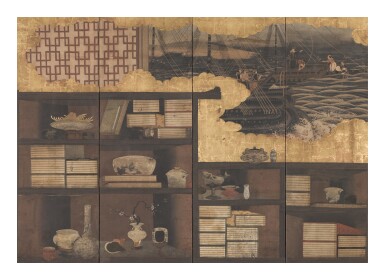Art of Japan
Art of Japan

Property from a Private European Collection
Anonymous | The arrival of Portuguese ships and scholar's accoutrements | Edo period, 17th century and later
Estimate
70,000 - 100,000 GBP
We may charge or debit your saved payment method subject to the terms set out in our Conditions of Business for Buyers.
Read more.Lot Details
Description
Property from a Private European Collection
Anonymous
The arrival of Portuguese ships and scholar's accoutrements
Edo period, 17th century and later
four-panel folding screen: ink, colour and gold on paper, silk brocade border, black lacquer mounts, engraved copper-gilt fittings
Each panel approx. 131.5 x 43.8 cm., 51¾ x 17¼ in.
Collection William C. Pahlmann, New York;
Acquired from the above by a Portuguese collector in 1972;
Thence by descent to the present owners
Photographed in William C. Pahlmann’s apartment in New York by Tom Leonard, possibly for House & Garden (see last image).
A large Portuguese trading ship, or nau do trato, appears to draw close to land. Once docked, Japanese and Europeans alike would flock to the port of Nagasaki on Japan’s southernmost island of Kyushu to purchase and exchange foreign goods. As can be seen on the book shelving cabinet that frames the scene as if viewed from a scholar’s window, the articles of trade were predominantly Chinese objects brought from Portuguese trading posts in Southeast Asia, such as Macao or Malacca on the Malay Peninsula.
Notably, the compositional elements reflect two distinctive and disparate painting traditions: the Korean still-life genre of bookshelves known as chaekgeori, or ‘books and things’, and nanban-jin torai-zu [lit. arrival of the southern barbarians]. In the former, books often placed beside scholars’ objects are the primary motif. The shelves typically extend continuously across all the panels, resulting in a unified depiction of a shelf over the entire surface of the screen. The latter depicted the arrival of early European merchants in Nagasaki to sell their wares to an excited Japanese clientele. Appropriate for the subject of foreign trade relations, the overall effect is a superimposition of two painting styles, with the shelves forming an architectural framework that places the viewer within the study opening onto a distant seascape. However, a further distinct cultural element is perceivable in the bookshelves themselves: the incorporation of Western linear perspective and shading techniques to create the illusion of recessed space.
Whereas chaekgeori became an established genre by the 1780s in the late Joseon period (1392-1910), nanban screens were mainly produced during the Momoyama to the early Edo period around the 1590s to the 1640s. Although it is unlikely that this genre of painting continued much after the ban on Christianity and expulsion of the Portuguese in 1639, recent scholarship suggests the theme may have continued to have been painted longer than previously thought. In the present example, the depiction of the trading and crew appear consistent with other examples of the genre; however, the placement of the bookshelves in the chaekgeori style in the foreground, suggests a later nineteenth century re-working of the screen perhaps either to alter previous wear or modify for contemporary taste.
Although often depicted with exaggerated and slightly caricatured European facial features, the crew here look conventionally more Japanese, suggesting a possible later dating for the nanban elements for this screen after the expulsion of the Portuguese and Christian religious persecutions. Their dress, however, is typically Portuguese and consistent with other contemporary depictions in similar genre scenes illustrating the arrival of foreign trade: billowy bombacha pantaloons, ornate hats delineated in gold pigment, capes, ruffled white collars and wrist cuffs. A notable distinguishing feature of this ‘Western’ subject is that the boat sails from left to right. In Japan, the instinctual way of viewing – and thus the flow of most Japanese compositions – is much like their writing system, which is read from top down and right to left. The movement from left to right thereby has the visual impact of an Occidentalism suitable to the subject of the arrival of western trade.
Among a variety of books stacked in haphazard fashion, the articles reflect the cross-cultural interactions of the period, and include a blue and white porcelain dish with finger citron, a Chinese Ge-type bottle vase with crackled glaze, a globular vase also with crackled glaze and loop handles bearing a prunus sprig, a red-glazed spittoon, known as zhadou or slops jars, and a vessel modelled as a carp placed horizontally on a wooden stand possibly sculpted from jade.
You May Also Like







